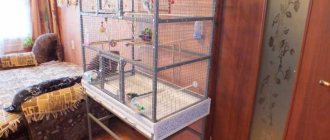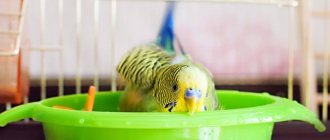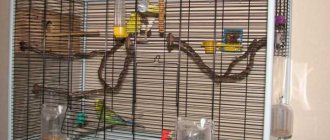When a feathered pet appears in the house, the owner is faced with the first difficulties: how to tame a budgerigar and how to help him adapt as quickly as possible. Taming an ornamental bird is a long process, but very interesting. If it is successful, the owner will not have problems with treatment, cleaning and other manipulations.
Wavys do not immediately go into a person’s hands. It takes more than one week to establish a trusting relationship: birds experience fear. What to do if a parrot is afraid, and how to overcome the psychological barrier?
How to tame a parrot: general rules
Ornithologists assure: the younger the bird, the easier it gets used to its new environment. The best age to start classes is 5 months. Chicks that are too small do not understand what is required of them and are difficult to train. It is more difficult to find a common language with adult birds, but it is quite possible.
The process of accustoming a wild parrot to hands takes place in several stages. Entry level: getting used to new conditions. Relocating to a new home is stressful for a bird, so the owner must be patient. You should postpone attempts to establish contact for 2–3 days while the pet adapts. Otherwise, he may become so frightened that he will never become tame.
In addition to the adaptation time, taming a parrot requires:
- correct actions;
- regular classes;
- taking into account the characteristics of birds.
From the first steps of taming, you need to interest your pet in communication. Talk calmly and kindly to your parrot as you walk past the cage or sit nearby. Every day, choose a place a little closer. Do not attempt to pick up the bird: this undermines trust.
Attention! Do not look into the eyes of your ward, look at the neck area, slightly closing the eyelids. For a cautious bird, a direct gaze is a sign of a predator.
When the human voice stops frightening the bird, you can move on to the next stage: slowly open the cage door and stick your palm inside with a smooth movement. If the bird is worried and screams, this is normal. With regular repetitions of the exercise he will get used to it. But you can’t touch it yet, trying to teach the parrot to sit on your hands. The bird will be frightened by such movements. The training process will have to start from the first stage.
How long will it take
You won’t be able to quickly win over your feathered friend. You need to gain the bird's trust gradually, without putting pressure on it. It is difficult to name the exact time frame in which a parrot will become tame. They depend on how it was fed as a chick, whether there were previous contacts with humans, and whether the pet was ever afraid of people.
Of course, the owner's behavior is most important. Rough treatment will permanently undermine the bird's trust. Affection and care, on the contrary, will help you earn his love.
How long does it take to train a parrot?
How to behave correctly with a parrot
When planning to tame a parrot, remember the rules of behavior. They help build trust in your pet and avoid mental problems.
It is important to talk to your pet as often as possible. This must be done in an even voice, calmly. When approaching the cage, you should gently pronounce your pet’s name so that he gradually gets used to it.
During taming, you should not swing your arms - the bird reflexively perceives such movements as a threat. In the wild, parrots flashing overhead is a signal that birds of prey are approaching. If the human hand is associated with danger, then it will be impossible to convince the pet. When the bird becomes completely tame, you can wave your arms in its presence without fear.
Important: When communicating with birds, shouting and punishment are unacceptable. If he tries to bite your finger, you need to understand that there are reasons for this: fear, self-defense. In such cases, you should calm the parrot with your voice or move away.
What difficulties arise?
When taming the wavy, people often encounter certain difficulties.
These include:
- the bird refuses to contact a person, but even if the parrot is very afraid and behaves cautiously, constant communication leads to the desired results, so you need to patiently continue taming;
- if the pet does not want to contact, then you can install a toy in the cage with which the person will play with his hands, and a mirror also helps a lot, increasing the bird’s confidence;
- If at the very beginning the parrot flew out of the cage, you should not try to catch it and forcefully return it to its place, so it is best to wait for darkness, remember the location of the wavy, and then calmly pick it up and transfer it to the perch.
If you catch a bird in the light, it will frighten it very much, so it will be difficult to establish contact.
Feeding
You can earn the trust of your ward with the help of treats. Even wild birds can take a treat from human hands. When the pet is no longer nervous at the sight of a hand in a cage, you can proceed to the next stage - feeding, which allows you to teach your budgie to sit on your hand.
To begin with, you can stretch a piece of apple or carrot on a toothpick. It is acceptable to use other food that the bird especially likes. After a few days, you can offer food lying in the palm of your hand. To take it, the wavy will have to touch his finger with his paw. This point is very important. The owner needs to be very careful, otherwise the shy bird will become alarmed.
If such training is carried out regularly, then soon your pet will learn to climb onto a person’s palm in search of a treat. At this time, you can try to gently stroke your pet's tummy or back. Over time, he will climb onto your hand even without a treat.
On a note! This taming stage can take a long time. The transition to palm sometimes takes several weeks. Be patient.
Acquaintance and adaptation
Changes in a bird's life, such as moving to a new owner, are always stressful. Like any living creature, a parrot needs time to accept them. It is normal for budgies to be afraid of new environments and people for the first 4-6 days.
In order for acquaintance and adaptation to be successful, it is necessary:
- give the bird enough time;
- take into account its characteristics (breed, character, health and age);
- act within certain rules;
- Communicate regularly with your pet, but do not impose.
During adaptation to a new home, it is better not to bother the bird. When the budgerigar gets comfortable in the cage, you can approach him for a short time and talk calmly.
Establishing communication with a little friend should occur on terms of mutual respect. You can't put your hands in the cage. A bird that is not accustomed to you will regard this as aggression.
Learning to walk
The next step in taming is to remove the hand with the bird sitting on it from the cage. At the first attempts, the bird will definitely jump off and hide in its house. By showing persistence and patience, you can ensure that the parrot gets used to the surrounding space and even makes flights.
During such familiarization walks, it is important to close the windows and leave other pets outside the door. You can cover the mirror with cloth to prevent the bird from getting injured.
If the pet voluntarily gets out of the cage and sits in your palm, we can assume that you have coped with the task of taming a budgie in your hands.
Learning simple tricks
Budgerigars are very musical. While singing, they often dance. Many breeders use this skill to teach birds to dance at the owner’s request.
It's not too difficult to do this. The main thing is that the “student” is tame. If a parrot is recently purchased, it must first adapt, then get used to being handled, and only after that can it be taught simple tricks.
Classes are held daily, 10–15 minutes. The parrot, who sits on the hand, is given dynamic melodies to listen to. The music shouldn't be too loud. Many wavy pets begin to dance on their own.
If this does not happen, the bird needs to be taught to move to the music:
- put on hand;
- turn on the music;
- move your hand rhythmically and shake your head to the beat.
Each training session must end with praise from the bird. Regular training with wavy pets always gives good results.
How to train a parrot to fly to you
One of the easiest ways to tame a budgie is to motivate it with treats. In order for the bird to fly from the cage to the owner without fear, you need to bring your palm with food to the entrance, gradually increasing the distance. The parrot will first have to flutter and then fly onto the palm.
Perhaps the pet will fly away with the treat. It’s worth trying to communicate affectionately with him at this time, carefully moving closer. The bird will understand that the person does not want to take away its food, and will begin to peck while sitting on the palm.
Attention! When your pet is comfortable enough, you can put him on your shoulder. From this position it is convenient for the bird to look around, while it feels under the protection of the owner.
Comfortable conditions
Before buying a parrot, think through all aspects of the pet’s comfortable living conditions, read the recommendations of experts, chat on forums and among your friends with those who have parrots.
When purchasing the necessary attributes, pay attention to the materials from which they are made
The cage should be spacious so that the parrot can move freely around it, spread its wings and wave them, jump from perch to ladder, and play with toys. The feeder usually comes with the cage. It is better to choose a ceramic or porcelain drinker rather than plastic. It costs more, but in such dishes harmful microflora develops more slowly, and the water stays clean longer. Choose toys made from environmentally friendly materials with high-quality coating.
What to do if you can’t lure your pet with a treat
A breeder may encounter the following problem: the pet does not respond to treats, categorically refusing to move to the hand. This is especially true when trying to tame adult budgies. But you can also find an approach to such individuals. To do this, you should carefully observe the bird and find what attracts it. For example, a mirror or a bell. Your favorite toy should be gradually moved away in such a way as to force the bird to climb onto your finger. The bird must overcome fear. When the psychological barrier is eliminated, the pet will begin to sit on your hand with pleasure.
The main rule for those who want to tame a parrot is no coercion. Birds remember their fears and grievances for a long time, and can lose trust in people for the rest of their lives. Therefore, the only possible way to a pet’s heart is a combination of affection, patience and tasty treats.
The third stage in establishing contact
A parrot that boldly and confidently sits on the owner's hand, easily moves onto the finger, can be released to fly around the room. But you need to prepare for this and ensure your pet’s safety. The door and windows must be closed. Mirror elements need to be hung. The bird may decide that it is a rival and enter into a battle, which will lead to injury. After preparation, you can open the cage. You should not rush the parrot; he will leave the house on his own and begin to explore the space. You can let the bird fly from your hand, let it sit on your finger and calmly take it out of the cage.
The pet can fly up from your finger on its own. You can give him a little toss so that he quickly realizes that he is free. Treats cannot be given to your pet outside the cage. He must understand that food awaits him only in the house. This will be a great incentive to return after flying.
While the bird is free, the cage must not be closed. The parrot must understand that it can return to its oasis of safety at any time. In the evening, the bird must be placed in a cage, since he must spend the night hours in his house.
Motivation with your favorite food
Rewarding desired behavior with tasty treats is the easiest way to train. Find out what your little friend likes to eat most, and only feed that food during training. It is important that it is safe for the pet. Bread, cookies, seeds or nuts are not suitable because consuming them in excess can be harmful to the birds. It is better to use pieces of fruits, vegetables, and berries for treats.











